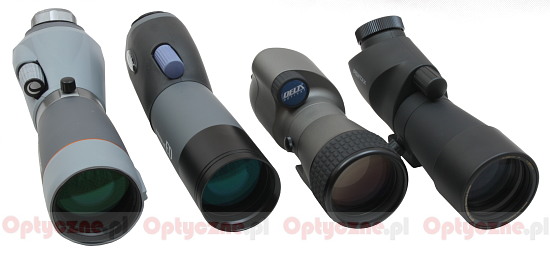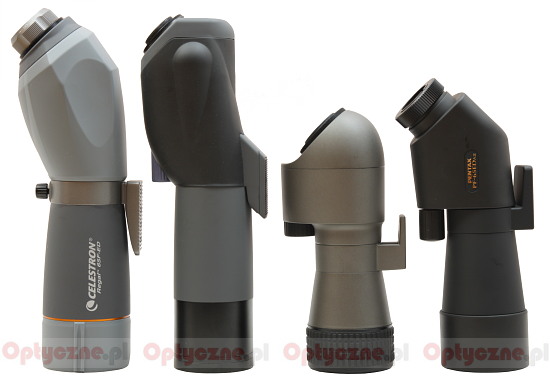Review of four 65 ED spotting scopes
1. Introduction
 |
We haven’t published any spotting scopes tests on the Optyczne.pl/Allbinos.com site yet although we have been thinking about doing so several times. Unfortunately conducting such tests is not an easy task – in fact it is far more complex than testing binoculars. The main difficulty lies in the fact that there are exchangeable eyepieces here. It is very hard to prepare a homogeneous test of a great number of models as it should be based on eyepieces which parameters are similar. It is certainly not as comfortable as in the case of binoculars where you can decide you want to deal, say, with the 10x42 class models and you choose several dozens of devices with the magnification ratio of exactly 10x.
The second problem is a huge magnification which demands using a tripod stand. If you want to compare spotting scopes directly it would be good to position them all side by side and point them at the same object. I can hardly imagine assessing a certain parameter by saving the data, detaching a spotting scope from a tripod to attach to it another one and repeating the same procedure over and over again. In our editorial office you can find 5-6 solid tripods without any problem so we can test only so many spotting scopes at the same time. Still we can’t dream of performing a really big test, with more than a dozen or even several dozen models as we’ve managed to do in the case of binoculars.
Please Support UsIf you enjoy our reviews and articles, and you want us to continue our work please, support our website by donating through PayPal. The funds are going to be used for paying our editorial team, renting servers, and equipping our testing studio; only that way we will be able to continue providing you interesting content for free. |
- - - - - - - - - - - - - - - - - - - - - - - - - - - - - - - - - - - - - - - - - - - - - - - -
Taking all reasons, listed above, into consideration and also several other factors which I won’t state here we decided to change the formula of our tests a bit. These will be rather mini tests, consisting of direct duels between particular spotting scopes and we will choose these instruments which have eyepieces of similar magnification ratios and fields of view as well. Unlike the binoculars’ tests there will be less charts and graphs and more descriptions.
Despite these simplifications we hope our tests will still help you to choose a piece of equipment you dream of.
Our first test is going to concern 65 mm spotting scopes with low dispersion glass. Why these ones? There are several reasons. First of all the 65 mm class means small, handy devices, which you are able to put into a backpack and take with you even on a longer hike. They don’t require a lot of space so you can keep them on a terrace or a loggia, permanently attached to a tripod and ready to be used whenever you want to. Using ED glass means that these instruments can have small dimensions. Previously fast spotting scopes with ordinary achromatic lenses always had a lot of problems with aberrations. You could diminish them but only by increasing the focal length and the dimensions as well. ED glass allows to preserve a short focal length and a good degree of aberration correction at the same time.
What’s more, good low dispersion glass used to be available only in the case of the top-of-the-range, pricey equipment. Since the Chinese plants learned the production process of that glass, its price decreased and it has become more common. Nowadays even spotting scopes which cost 1000- 2000 PLN can feature it so a far bigger number of people can enjoy it. The increased interest in this market segment has encouraged the producers to enlarge their offer in turn – small wonder so many new instruments of this class have been launched lately and novelties, being always the most enticing devices, just need to be tested.
We would like to thank Delta Optical and Fotozakupy.pl. companies for lending us the equipment for the testing purposes.
 |






